Chapter 2 : The Judiciary and The Environment
Added on 2020-01-28
51 Pages19639 Words35 Views
The Role of the Judiciary of Sierra
Leone in the enforcement of
environmental regulations
Leone in the enforcement of
environmental regulations
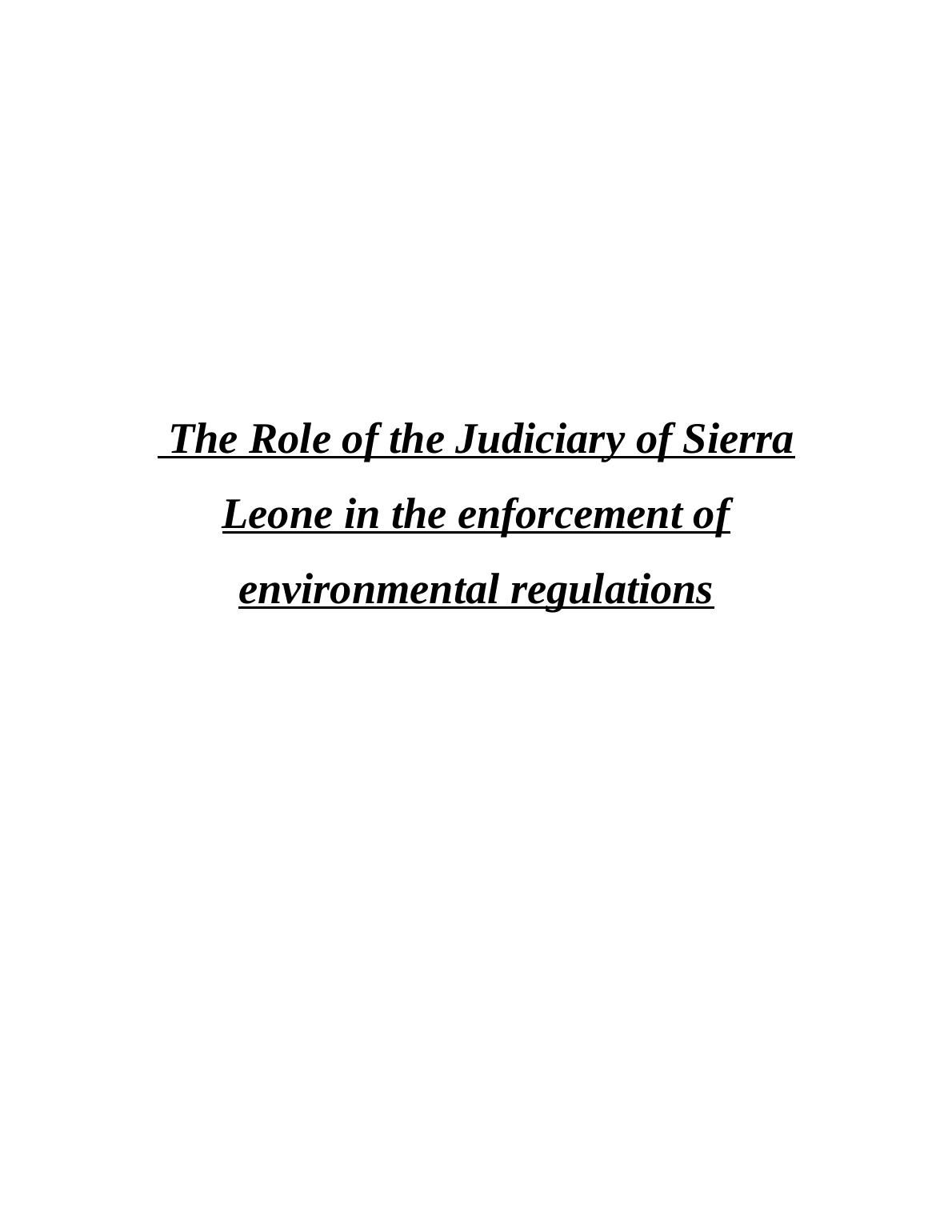
Table of Contents
CHAPTER 1 : INTRODUCTION...................................................................................................1
1.1 Background objectives.....................................................................................................1
1.2 The Development of Environmental Laws in Sierra Leone.............................................2
1.3 Provisions of Environmental Laws and Regulations in Sierra Leone..............................3
1.4 The Deficiencies and Challenges of Environmental Law enforcement...........................7
CHAPTER 2 : THE JUDICIARY AND THE ENVIRONMENT.................................................10
2.1 The role of the Judiciary..........................................................................................................10
2.2 Importance of judges for the rule of law and environmental protection........................12
2.3 Jurisdiction over environmental cases............................................................................13
2.4 Judicial remedies available for environmental protection..............................................14
CHAPTER 3 : ENFORCEMENT OF THE PRECAUTIONARY PRINCIPLE...........................18
3.1 Concepts enshrined in the precautionary principle........................................................18
3.2 Conditions under which precautionary principles apply................................................20
3.3 Processes and measures applicable to the implementation and operation of precautionary
principle................................................................................................................................23
3.4 Principles of Risk Management......................................................................................26
3.5 Processes and mechanism necessary for implementation..............................................28
3.6Making precautionary measures operational...................................................................31
CHAPTER 4: THE WAY FORWARD.........................................................................................33
4.1 Need for an environmental court....................................................................................33
4.2 An Environmental Charter- A new role of courts..........................................................35
4.3 Environmental law awareness........................................................................................37
4.4 Judicial cooperation........................................................................................................39
4.5 Creating a ‘green bench’................................................................................................39
CHAPTER 5: CONCLUSION......................................................................................................40
REFERENCES..............................................................................................................................43
CHAPTER 1 : INTRODUCTION...................................................................................................1
1.1 Background objectives.....................................................................................................1
1.2 The Development of Environmental Laws in Sierra Leone.............................................2
1.3 Provisions of Environmental Laws and Regulations in Sierra Leone..............................3
1.4 The Deficiencies and Challenges of Environmental Law enforcement...........................7
CHAPTER 2 : THE JUDICIARY AND THE ENVIRONMENT.................................................10
2.1 The role of the Judiciary..........................................................................................................10
2.2 Importance of judges for the rule of law and environmental protection........................12
2.3 Jurisdiction over environmental cases............................................................................13
2.4 Judicial remedies available for environmental protection..............................................14
CHAPTER 3 : ENFORCEMENT OF THE PRECAUTIONARY PRINCIPLE...........................18
3.1 Concepts enshrined in the precautionary principle........................................................18
3.2 Conditions under which precautionary principles apply................................................20
3.3 Processes and measures applicable to the implementation and operation of precautionary
principle................................................................................................................................23
3.4 Principles of Risk Management......................................................................................26
3.5 Processes and mechanism necessary for implementation..............................................28
3.6Making precautionary measures operational...................................................................31
CHAPTER 4: THE WAY FORWARD.........................................................................................33
4.1 Need for an environmental court....................................................................................33
4.2 An Environmental Charter- A new role of courts..........................................................35
4.3 Environmental law awareness........................................................................................37
4.4 Judicial cooperation........................................................................................................39
4.5 Creating a ‘green bench’................................................................................................39
CHAPTER 5: CONCLUSION......................................................................................................40
REFERENCES..............................................................................................................................43
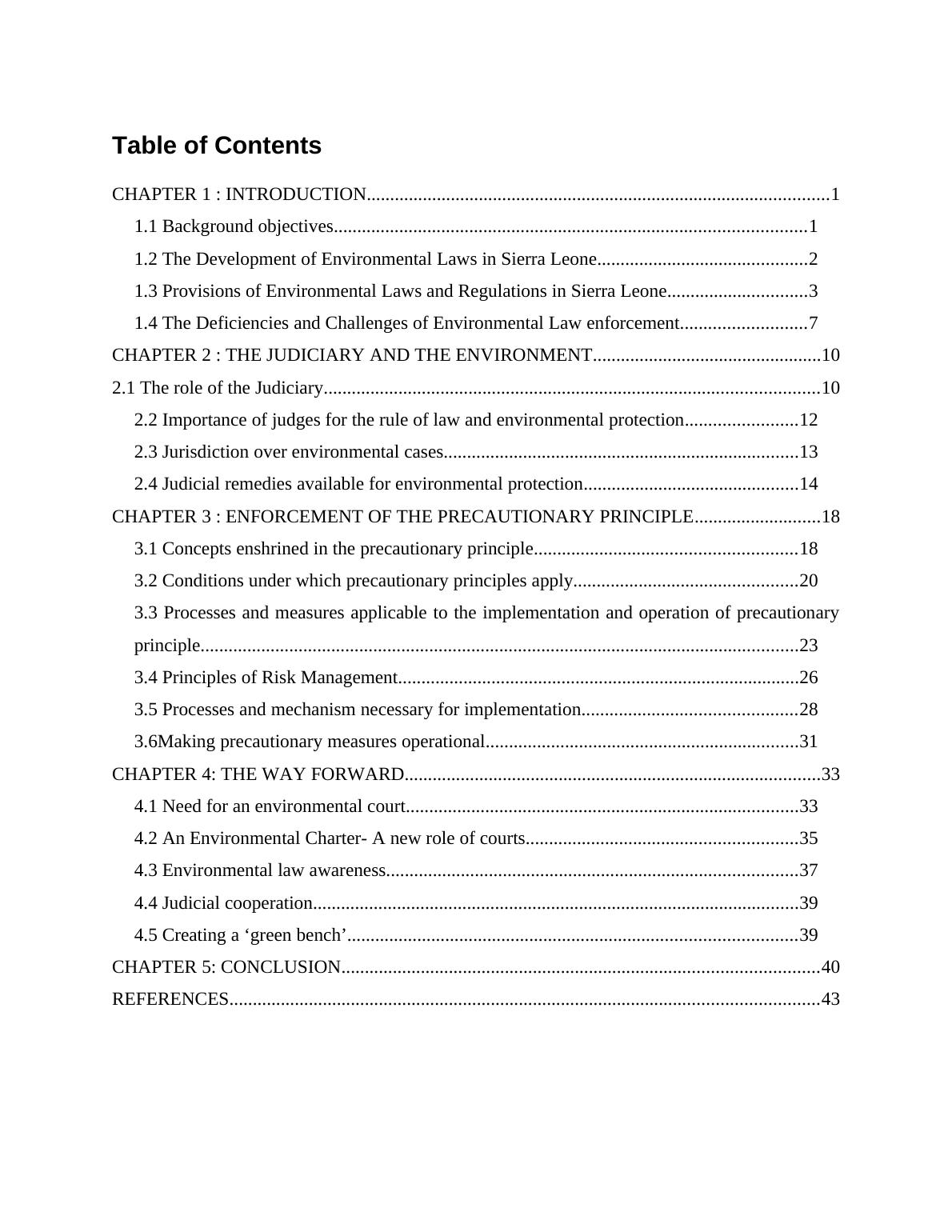
CHAPTER 1 : INTRODUCTION
1.1 Background objectives
Environment law is determined as the collection of various regulations, treaties, common
laws, statutes and customary laws that address the impact on the natural environment caused due
to human activities.1 As a result of increase in population and various human activities,
numerous environmental issue are arising, therefore, it has become imperative to make such laws
and regulations that ensure environmental protection and minimises the impact of human
activities on the nature.
Sierra Leone is a West African country and its economy is based mainly on mining and
agriculture. The mining activities have an adverse effect on the natural environment so various
laws are established by the judiciary for its maintenance and protection. Laws and regulations are
interpreted and applied by the Judiciary of Sierra Leone which is the governmental branch of
Republic of Sierra Leone. It ensures that law is providing justice impartially and a mechanism is
provided for resolution of disputes. Environmental Protection Act, 2000 is a key initiative taken
by the government that provides for stringent regulatory framework for environment regulations
in Sierra Leone. Apart from this, various other legislations are formed such as Mines and
Minerals Act, 2009, Environment Protection Agency Act, 2008, Nuclear Safety and Radiation
Protection Act, 2012, the Merchant Shipping Act of 2003, the National Protected Area Authority
and Conservation Trust Fund Act 2012 etc. that seeks to address protection of environment,
safety and health and development of community.
The country is facing numerous problems related to environment including loss of
biodiversity, deforestation, air pollution, degradation, loss of soil fertility and water pollution.
All these issues hamper the development and progress of the nation. The formulation of laws
were a vital step taken by the Judiciary of Sierra Leone that seeks to resolve all these issues and
promote development of country's economy. The present report focuses on the development of
environmental laws in Sierra Leone for the protection and sustainability of nature and natural
resources. The provisions and regulations provided by different acts and legislations are
discussed and analysed in this assignment.2 Further, the study throws a light on the challenges
and deficiencies in the enforcement of environment law.
1 Rodman, K. A., 2013. Justice is interventionist: The political sources of the judicial reach of the special court
for Sierra Leone. International Criminal Law Review. 13(1). pp.63-91.
1
1.1 Background objectives
Environment law is determined as the collection of various regulations, treaties, common
laws, statutes and customary laws that address the impact on the natural environment caused due
to human activities.1 As a result of increase in population and various human activities,
numerous environmental issue are arising, therefore, it has become imperative to make such laws
and regulations that ensure environmental protection and minimises the impact of human
activities on the nature.
Sierra Leone is a West African country and its economy is based mainly on mining and
agriculture. The mining activities have an adverse effect on the natural environment so various
laws are established by the judiciary for its maintenance and protection. Laws and regulations are
interpreted and applied by the Judiciary of Sierra Leone which is the governmental branch of
Republic of Sierra Leone. It ensures that law is providing justice impartially and a mechanism is
provided for resolution of disputes. Environmental Protection Act, 2000 is a key initiative taken
by the government that provides for stringent regulatory framework for environment regulations
in Sierra Leone. Apart from this, various other legislations are formed such as Mines and
Minerals Act, 2009, Environment Protection Agency Act, 2008, Nuclear Safety and Radiation
Protection Act, 2012, the Merchant Shipping Act of 2003, the National Protected Area Authority
and Conservation Trust Fund Act 2012 etc. that seeks to address protection of environment,
safety and health and development of community.
The country is facing numerous problems related to environment including loss of
biodiversity, deforestation, air pollution, degradation, loss of soil fertility and water pollution.
All these issues hamper the development and progress of the nation. The formulation of laws
were a vital step taken by the Judiciary of Sierra Leone that seeks to resolve all these issues and
promote development of country's economy. The present report focuses on the development of
environmental laws in Sierra Leone for the protection and sustainability of nature and natural
resources. The provisions and regulations provided by different acts and legislations are
discussed and analysed in this assignment.2 Further, the study throws a light on the challenges
and deficiencies in the enforcement of environment law.
1 Rodman, K. A., 2013. Justice is interventionist: The political sources of the judicial reach of the special court
for Sierra Leone. International Criminal Law Review. 13(1). pp.63-91.
1
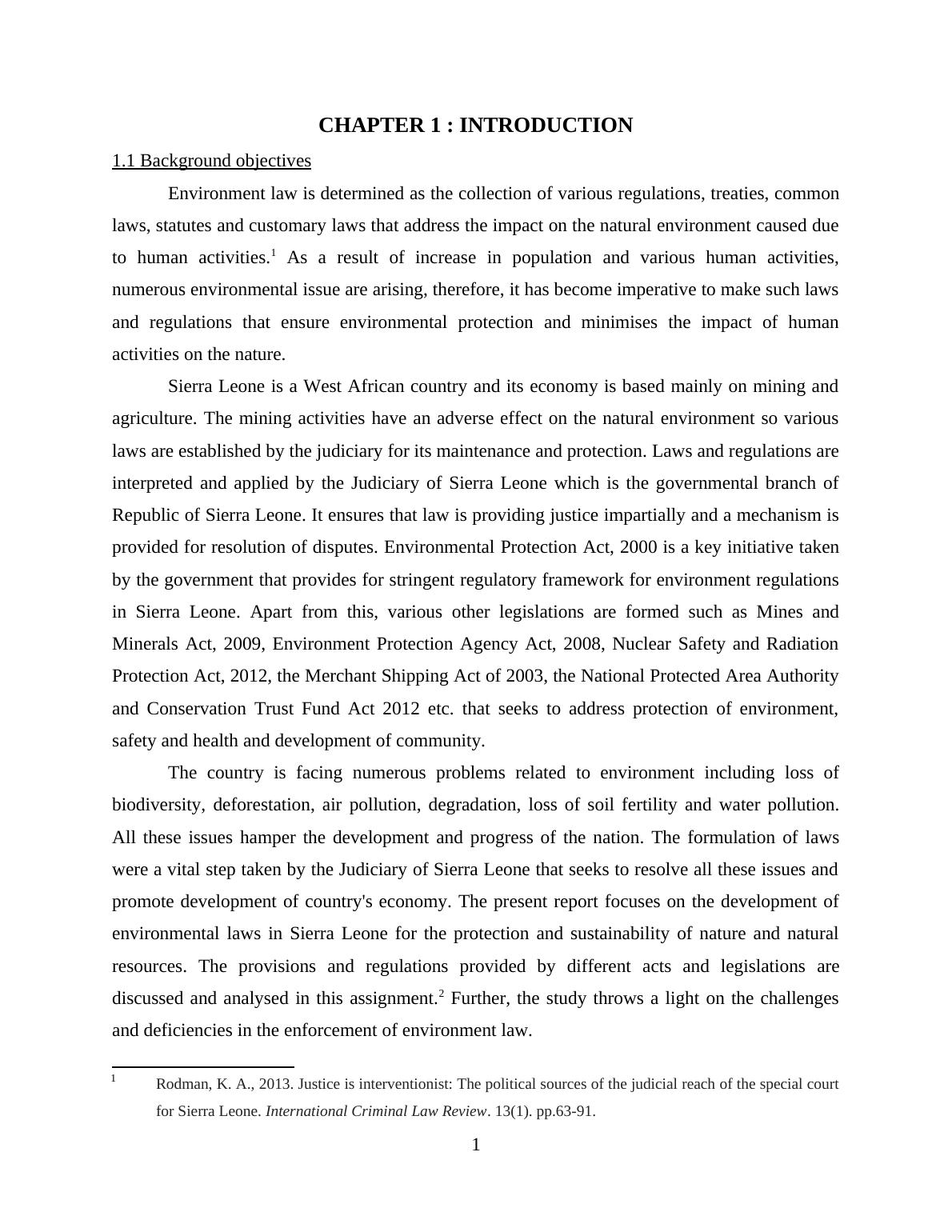
The report emphasises on the judiciary of Sierra Leone that plays a cardinal role in
interpretation and application of laws to ensure impartial justice and also assists in resolution of
disputes. The constitution provides guarantee and assurance for the independence and integrity
of Judiciary while performing its duties. The judicial system consists of inferior courts that are
represented by Magistrate courts, then there are superior courts and local courts that are
represented by Court of Appeal, High Court and the Supreme Court. The justice of Supreme
Court is appointed by the President who is advised by the Judicial and Legal Service
Commission and the appointment is subjected to approval of Parliament. The judges of asuperior
courts are also appointed in the same manner, except that approval of Parliament is not required.
The judges play a key role in the judicial system of Sierra Leone by ensuring compliance of laws
and statutes and providing justice without any bias to the citizens of the country.
Moreover, this assignment provides an understanding of precautionary principles to the
risk management. It states that when any policy or action is suspected to cause harm to
environment or public, the onus to prove that such action is not harmful would lie on those
taking that action where is the scientific consensus is absent.3 The study explains the conditions
under which precautionary principles are applied, measures and processes applicable for its
implementation and operations and the principles of risk management. In addition to this, need
for environmental courts, judicial cooperation and creation of green bench are addressed in the
report.
1.2 The Development of Environmental Laws in Sierra Leone
Sierra Leone is a country in West Africa that is rich in minerals. The economy of the
country is mainly based on the mining and agricultural activities due to which various
environmental issues arises. It faces a number of problems related to environment such as
deforestation, lack of biodiversity, degradation, loss of soil fertility, air pollution and water
pollution that hinder the progress and development of the economy of the country. The primary
identified environment problems include deforestation, water supply and sanitation, tourism,
forest degradation, land degradation, fisheries, mining and manufacturing. The biodiversity of
2 Hoberg, G., 2012. Pluralism by design: Environmental policy and the American regulatory state. Greenwood
Publishing Group.
3 Parker, A., 2011. ALSO IN THIS ISSUE: Racial Disparities in US Public Education and International
Human Rights Standards: Holding the US Accountable to CERD. Hum. Rts. Br. 14. pp.27-70.
2
interpretation and application of laws to ensure impartial justice and also assists in resolution of
disputes. The constitution provides guarantee and assurance for the independence and integrity
of Judiciary while performing its duties. The judicial system consists of inferior courts that are
represented by Magistrate courts, then there are superior courts and local courts that are
represented by Court of Appeal, High Court and the Supreme Court. The justice of Supreme
Court is appointed by the President who is advised by the Judicial and Legal Service
Commission and the appointment is subjected to approval of Parliament. The judges of asuperior
courts are also appointed in the same manner, except that approval of Parliament is not required.
The judges play a key role in the judicial system of Sierra Leone by ensuring compliance of laws
and statutes and providing justice without any bias to the citizens of the country.
Moreover, this assignment provides an understanding of precautionary principles to the
risk management. It states that when any policy or action is suspected to cause harm to
environment or public, the onus to prove that such action is not harmful would lie on those
taking that action where is the scientific consensus is absent.3 The study explains the conditions
under which precautionary principles are applied, measures and processes applicable for its
implementation and operations and the principles of risk management. In addition to this, need
for environmental courts, judicial cooperation and creation of green bench are addressed in the
report.
1.2 The Development of Environmental Laws in Sierra Leone
Sierra Leone is a country in West Africa that is rich in minerals. The economy of the
country is mainly based on the mining and agricultural activities due to which various
environmental issues arises. It faces a number of problems related to environment such as
deforestation, lack of biodiversity, degradation, loss of soil fertility, air pollution and water
pollution that hinder the progress and development of the economy of the country. The primary
identified environment problems include deforestation, water supply and sanitation, tourism,
forest degradation, land degradation, fisheries, mining and manufacturing. The biodiversity of
2 Hoberg, G., 2012. Pluralism by design: Environmental policy and the American regulatory state. Greenwood
Publishing Group.
3 Parker, A., 2011. ALSO IN THIS ISSUE: Racial Disparities in US Public Education and International
Human Rights Standards: Holding the US Accountable to CERD. Hum. Rts. Br. 14. pp.27-70.
2

Sierra Leone was well endowed with natural resources but it failed to sustain its rich and diverse
resources due to activities such as fishing, mining, infrastructure development, hunting, farming
etc. which affected the ecosystem.4 The country faces enormous environmental threats –
destruction of rain forests due to logging, deforestation of beautiful mountains, wild life species
are becoming endangered, environmental pollution is created due to dumping of scrap machines.
The use of charcoal and woods for cooking which increases the quantum of carbon dioxide in the
air and has led to an alarming increase in air pollution which causes several health problems to
the citizens.
To address all these issues and for the protection of environment, the government had to
take various steps in order to ensure sustainability and maintaining ecological balance.5 For
solving the problems of deforestation, the government of Sierra Leone has adopted policy for
preservation of vegetation and plantation of trees in consultation with the Ministry of Lands,
Country Planning and the Environment. Another measure was taken for the prevention of
degradation whereby government has put a ban on hunting and logging of trees in the forests.
The major initiative taken was the development of Environment Protection Act, 2000 which was
formed with the key purpose to protect the natural resources and wildlife and minimize the
impact of human activities on environment in Sierra Leone (Kelly, Barrie and Bausch, 2013).
There are some other acts also that are developed with the purpose to address the environmental
issues namely Mines and Minerals Act, 2009, Environment Protection Agency Act, 2008,
Nuclear Safety and Radiation Protection Act, 2012, the Merchant Shipping Act of 2003, the
National Protected Area Authority and Conservation Trust Fund Act 2012 etc.
1.3 Provisions of Environmental Laws and Regulations in Sierra Leone
a.i.a. Environment Protection Agency Act 2008 :
The Environment Protection Agency Act established Environment Protection Agency
(EPA) in 2008 that begin its operations in 2009. It is the main agency of Sierra Leone
government that is concerned with the changes in environment and climate. The agency
encompasses responsibilities for coordinating and monitoring the activities regarding legislation
4 Rackley, E., 2010. What a difference difference makes: Gendered harms and judicial diversity. International
Journal of the Legal Profession. 15(1-2). pp.37-56.
5 Panel on the Law of Ocean Uses, 2012. United States Interests in the Law of the Sea Convention. American
Journal of International Law, pp.167-178.
3
resources due to activities such as fishing, mining, infrastructure development, hunting, farming
etc. which affected the ecosystem.4 The country faces enormous environmental threats –
destruction of rain forests due to logging, deforestation of beautiful mountains, wild life species
are becoming endangered, environmental pollution is created due to dumping of scrap machines.
The use of charcoal and woods for cooking which increases the quantum of carbon dioxide in the
air and has led to an alarming increase in air pollution which causes several health problems to
the citizens.
To address all these issues and for the protection of environment, the government had to
take various steps in order to ensure sustainability and maintaining ecological balance.5 For
solving the problems of deforestation, the government of Sierra Leone has adopted policy for
preservation of vegetation and plantation of trees in consultation with the Ministry of Lands,
Country Planning and the Environment. Another measure was taken for the prevention of
degradation whereby government has put a ban on hunting and logging of trees in the forests.
The major initiative taken was the development of Environment Protection Act, 2000 which was
formed with the key purpose to protect the natural resources and wildlife and minimize the
impact of human activities on environment in Sierra Leone (Kelly, Barrie and Bausch, 2013).
There are some other acts also that are developed with the purpose to address the environmental
issues namely Mines and Minerals Act, 2009, Environment Protection Agency Act, 2008,
Nuclear Safety and Radiation Protection Act, 2012, the Merchant Shipping Act of 2003, the
National Protected Area Authority and Conservation Trust Fund Act 2012 etc.
1.3 Provisions of Environmental Laws and Regulations in Sierra Leone
a.i.a. Environment Protection Agency Act 2008 :
The Environment Protection Agency Act established Environment Protection Agency
(EPA) in 2008 that begin its operations in 2009. It is the main agency of Sierra Leone
government that is concerned with the changes in environment and climate. The agency
encompasses responsibilities for coordinating and monitoring the activities regarding legislation
4 Rackley, E., 2010. What a difference difference makes: Gendered harms and judicial diversity. International
Journal of the Legal Profession. 15(1-2). pp.37-56.
5 Panel on the Law of Ocean Uses, 2012. United States Interests in the Law of the Sea Convention. American
Journal of International Law, pp.167-178.
3
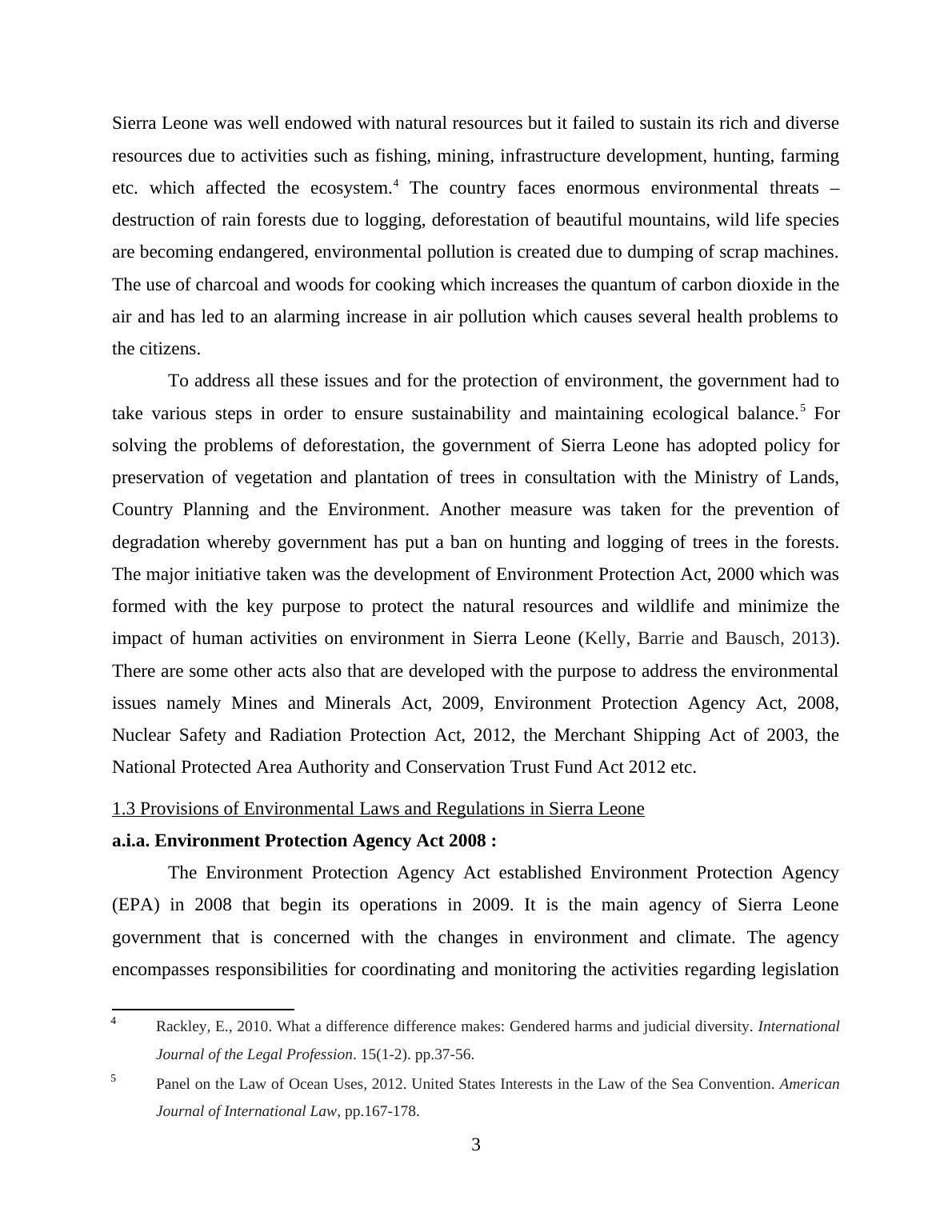
of environment protection, its implementation and to ensure national environmental policies are
complied and also pollution, waste processing and other environmental hazards are monitored.
The main purpose of establishing EPA was to create and enforce a stringent regulatory
framework for environmental regulation in the country.6 It is responsible for monitoring,
coordinating and evaluating implementation of national environmental projects, programmes and
policies and issue of licenses in relation with Environment Impact Assessment (EIA). According
to the provisions of Section 23 (1) of the Environment Protection Agency Act, 2008, no person is
allowed for undertaking projects that substantially affect the environment without the agency has
issued a permit for such projects namely agriculture, construction of infrastructure and
extraction. Further, it provides that Agency ensures compliance of this provision and the person
acting in contravention of these provisions would be held liable for legal prosecution and
punishment.
a.i.b. The Nuclear Safety and Radiation Protection Act 2012 :
The Nuclear Safety and Radiation Protection Act provides for establishing Nuclear
Safety and Radiation Protection Authority for exercising supervisory and regulatory control on
radioactive substances and their application for peaceful and beneficial uses (Cho, Ogwang and
Opio, 2010). It is developed with the purpose of providing adequate safety to the environment,
workers and public from the harmful effects of radiation by ensuring licensing, enforcement and
inspection throughout Sierra Leone. The authority is responsible for radiation protection, waste
safety, nuclear safety and security and also non – ionizing radiations. It also ensures for meeting
obligations with regard to various international treaties and agreements such as he Treaty on
Non-Proliferation of Nuclear Weapons and the Agreement between Sierra Leone and the
International Atomic Energy Agency (IAEA) for the Application of Safeguards in Connection
with the Non-Proliferation Treaty.
a.i.c. The National Protected Area Authority and Conservation Trust Fund Act 2012 :
As per the provisions of the National Protected Area Authority and Conservation Trust
Fund Act 2012, National Protected Area Authority (NPAA) and Conservation Trust Fund is
established in Sierra Leone.7 The main objective of the Act is promotion of conservation of
biodiversity, research and wildlife management and also provides for sale of ecosystem services
6 Dixon, M., McCorquodale, R. and Williams, S., 2011. Cases and materials on international law. Oxford
University Press.
4
complied and also pollution, waste processing and other environmental hazards are monitored.
The main purpose of establishing EPA was to create and enforce a stringent regulatory
framework for environmental regulation in the country.6 It is responsible for monitoring,
coordinating and evaluating implementation of national environmental projects, programmes and
policies and issue of licenses in relation with Environment Impact Assessment (EIA). According
to the provisions of Section 23 (1) of the Environment Protection Agency Act, 2008, no person is
allowed for undertaking projects that substantially affect the environment without the agency has
issued a permit for such projects namely agriculture, construction of infrastructure and
extraction. Further, it provides that Agency ensures compliance of this provision and the person
acting in contravention of these provisions would be held liable for legal prosecution and
punishment.
a.i.b. The Nuclear Safety and Radiation Protection Act 2012 :
The Nuclear Safety and Radiation Protection Act provides for establishing Nuclear
Safety and Radiation Protection Authority for exercising supervisory and regulatory control on
radioactive substances and their application for peaceful and beneficial uses (Cho, Ogwang and
Opio, 2010). It is developed with the purpose of providing adequate safety to the environment,
workers and public from the harmful effects of radiation by ensuring licensing, enforcement and
inspection throughout Sierra Leone. The authority is responsible for radiation protection, waste
safety, nuclear safety and security and also non – ionizing radiations. It also ensures for meeting
obligations with regard to various international treaties and agreements such as he Treaty on
Non-Proliferation of Nuclear Weapons and the Agreement between Sierra Leone and the
International Atomic Energy Agency (IAEA) for the Application of Safeguards in Connection
with the Non-Proliferation Treaty.
a.i.c. The National Protected Area Authority and Conservation Trust Fund Act 2012 :
As per the provisions of the National Protected Area Authority and Conservation Trust
Fund Act 2012, National Protected Area Authority (NPAA) and Conservation Trust Fund is
established in Sierra Leone.7 The main objective of the Act is promotion of conservation of
biodiversity, research and wildlife management and also provides for sale of ecosystem services
6 Dixon, M., McCorquodale, R. and Williams, S., 2011. Cases and materials on international law. Oxford
University Press.
4
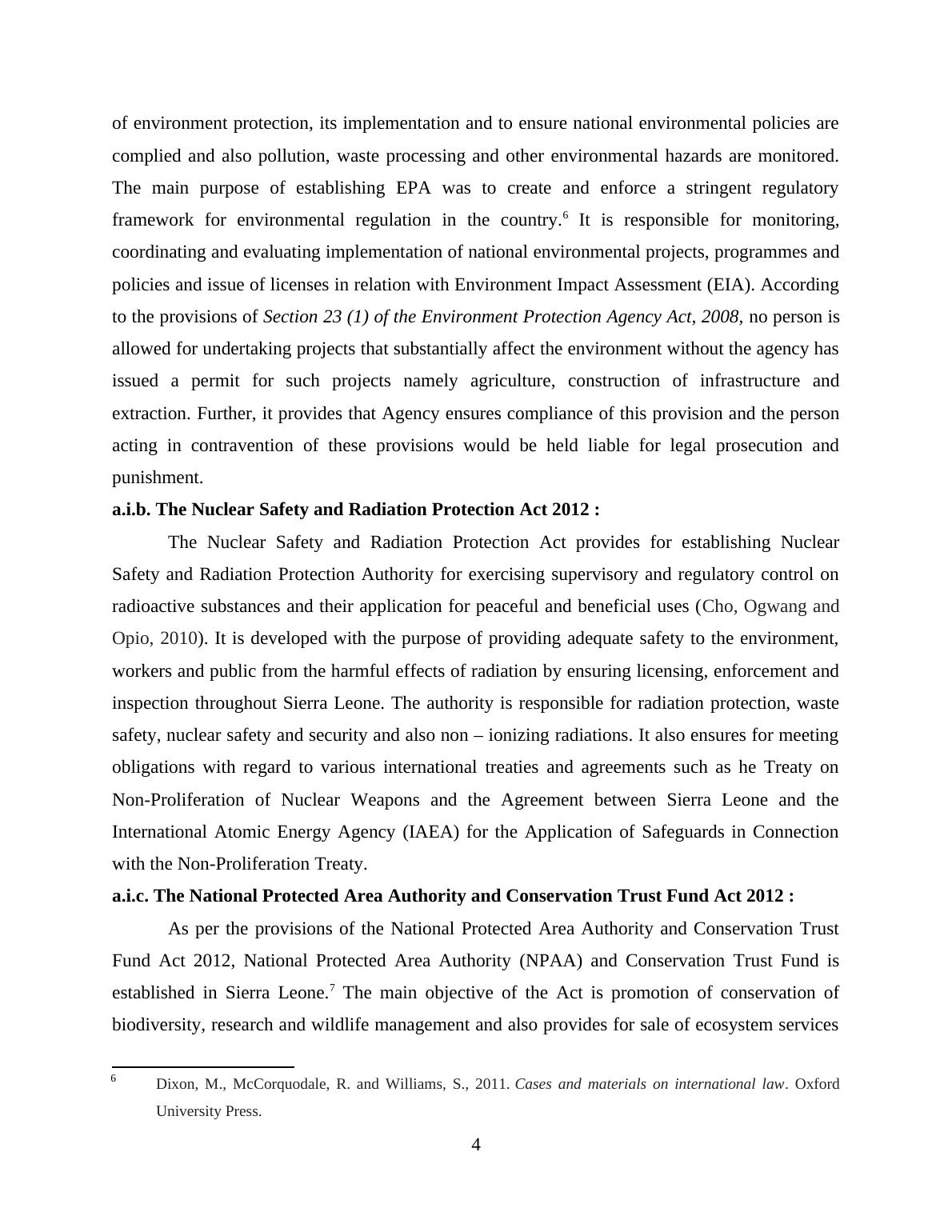
in the national protected areas. The role of NPAA is stated in part III of the Act whereby it is
required to exercise authority and oversight over National Parks and Protected Areas which are
assigned for the purpose of conservation, promotion of sustainable environmental management
and use of sustainable land practices. Moreover, according to section III (f) of the Act,
collaboration with stakeholders for forming national REDD+ Strategy and promoting REDD+
projects as a sustainable source of finance in the country for protected area management is
another function of NPAA. Further, Section III (xi) provides for promoting co management with
communities of local forest edge both within and outside the protected areas for natural resources
of NPAA.
a.i.d The Mines and Minerals Act, 2009 and Statutory Instrument of 2012 :
Sierra Leone is rich in resources and minerals such as diamonds, bauxite, gold, iron ore,
rutile etc. The economy of the country is primarily based on mining and agriculture. But the
increase in mining activities have adversely impacted the environment and natural resources of
Sierra Leone.8 Mining sector has undergone various reforms over last few years. The first piece
of mining legislation was enactment of Minerals Act, 1927 which was modified in 1960 as
Revised Minerals Act which has been amended over the years. But all these laws failed to
provide desired results and were not sufficient for resolving the issues of environment, economic
and social development, community issues and health and safety of people.
Sierra Leone has adopted several rules and regulations in order to tackle such criticisms
and for promotion of transparency, stronger governance, local content and to encourage foreign
investments :
7 National Protected Area Authority and Conservation Trust Fund Act, 2012. 2015.
<http://www.ecolex.org/details/legislation/national-protected-area-authority-and-
conservation-trust-fund-act-2012-no-11-of-2012-lex-faoc150279/> Accessed on 21st March
2017
8 Okowa, P., 2010, May. Interpreting Constitutive Instruments of International Criminal Tribunals: Reflections
on the Special Court for Sierra Leone. In Treaty Interpretation and the Vienna Convention on the Law of
Treaties: 30 Years on. (pp. 333-356). Brill.
5
required to exercise authority and oversight over National Parks and Protected Areas which are
assigned for the purpose of conservation, promotion of sustainable environmental management
and use of sustainable land practices. Moreover, according to section III (f) of the Act,
collaboration with stakeholders for forming national REDD+ Strategy and promoting REDD+
projects as a sustainable source of finance in the country for protected area management is
another function of NPAA. Further, Section III (xi) provides for promoting co management with
communities of local forest edge both within and outside the protected areas for natural resources
of NPAA.
a.i.d The Mines and Minerals Act, 2009 and Statutory Instrument of 2012 :
Sierra Leone is rich in resources and minerals such as diamonds, bauxite, gold, iron ore,
rutile etc. The economy of the country is primarily based on mining and agriculture. But the
increase in mining activities have adversely impacted the environment and natural resources of
Sierra Leone.8 Mining sector has undergone various reforms over last few years. The first piece
of mining legislation was enactment of Minerals Act, 1927 which was modified in 1960 as
Revised Minerals Act which has been amended over the years. But all these laws failed to
provide desired results and were not sufficient for resolving the issues of environment, economic
and social development, community issues and health and safety of people.
Sierra Leone has adopted several rules and regulations in order to tackle such criticisms
and for promotion of transparency, stronger governance, local content and to encourage foreign
investments :
7 National Protected Area Authority and Conservation Trust Fund Act, 2012. 2015.
<http://www.ecolex.org/details/legislation/national-protected-area-authority-and-
conservation-trust-fund-act-2012-no-11-of-2012-lex-faoc150279/> Accessed on 21st March
2017
8 Okowa, P., 2010, May. Interpreting Constitutive Instruments of International Criminal Tribunals: Reflections
on the Special Court for Sierra Leone. In Treaty Interpretation and the Vienna Convention on the Law of
Treaties: 30 Years on. (pp. 333-356). Brill.
5
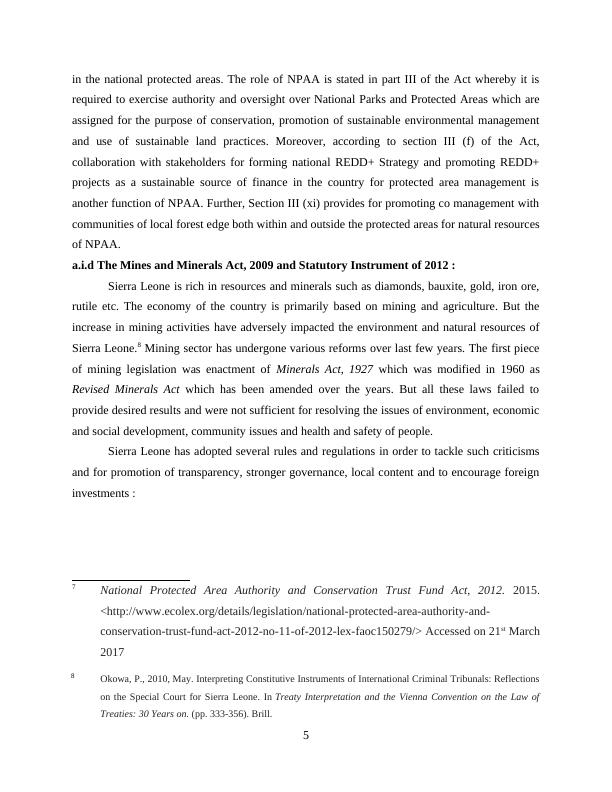
The government issued a “ Core Mineral Policy” in 2003 which stated ten strategic
objectives which included promotion of private investments and ensuring that the wealth
of the nation supports its social and economic development.9
Investment Protection Act was passed by the legislature in 2004 which seeks to provide
several guarantees to foreign investors with regard to fund transfer, resolution of diputes
and expropriations. Environment Protection Act, 2008 was passed with the aim to regulate mining projects
and provided for assessment of environmental impact and issuance of its license to
undertake the mining projects.
The Mines and Minerals Act, 2009 replaced the act of 1994 and brought various
changes. Following are the main provisions of the act :
1. It clearly defines the principle of 'first come first served basis' and provide assistance to
government for awarding mineral rights on the basis of public tender.
2. It states that :
the companies registered in Sierra Leone are only entitled to get the license for
exploration and large scale mining.10
The initial period for which exploration license would be granted will be of 4 years and
the maximum area covered would be 250 sq kms.
The initial period for which large scale mining license will be granted is for 25 years and
on the basis of terms of mining agreement, interest in large scale mining operations can
be acquired by the state.
3. The acts provide for maintenance of a register of mineral rights in which various detail such as
renewals, grants, transfers, area enlargement and relinquishment, forfeitures, surrenders,
attachments, revocations, pledges, encumbrances, discoveries, fees paid, reports submitted,
9 Okowa, P., 2010, May. Interpreting Constitutive Instruments of International Criminal Tribunals: Reflections
on the Special Court for Sierra Leone. In Treaty Interpretation and the Vienna Convention on the Law of
Treaties: 30 Years on. (pp. 333-356). Brill.
10 Mining in Sierra Leone: an overview of the current legal framework. 2015.
<http://www.lexology.com/library/detail.aspx?g=0f68dda3-1d7a-4770-b96a-d6df219e3fd0>. Accessed on
30th March 2017
6
objectives which included promotion of private investments and ensuring that the wealth
of the nation supports its social and economic development.9
Investment Protection Act was passed by the legislature in 2004 which seeks to provide
several guarantees to foreign investors with regard to fund transfer, resolution of diputes
and expropriations. Environment Protection Act, 2008 was passed with the aim to regulate mining projects
and provided for assessment of environmental impact and issuance of its license to
undertake the mining projects.
The Mines and Minerals Act, 2009 replaced the act of 1994 and brought various
changes. Following are the main provisions of the act :
1. It clearly defines the principle of 'first come first served basis' and provide assistance to
government for awarding mineral rights on the basis of public tender.
2. It states that :
the companies registered in Sierra Leone are only entitled to get the license for
exploration and large scale mining.10
The initial period for which exploration license would be granted will be of 4 years and
the maximum area covered would be 250 sq kms.
The initial period for which large scale mining license will be granted is for 25 years and
on the basis of terms of mining agreement, interest in large scale mining operations can
be acquired by the state.
3. The acts provide for maintenance of a register of mineral rights in which various detail such as
renewals, grants, transfers, area enlargement and relinquishment, forfeitures, surrenders,
attachments, revocations, pledges, encumbrances, discoveries, fees paid, reports submitted,
9 Okowa, P., 2010, May. Interpreting Constitutive Instruments of International Criminal Tribunals: Reflections
on the Special Court for Sierra Leone. In Treaty Interpretation and the Vienna Convention on the Law of
Treaties: 30 Years on. (pp. 333-356). Brill.
10 Mining in Sierra Leone: an overview of the current legal framework. 2015.
<http://www.lexology.com/library/detail.aspx?g=0f68dda3-1d7a-4770-b96a-d6df219e3fd0>. Accessed on
30th March 2017
6
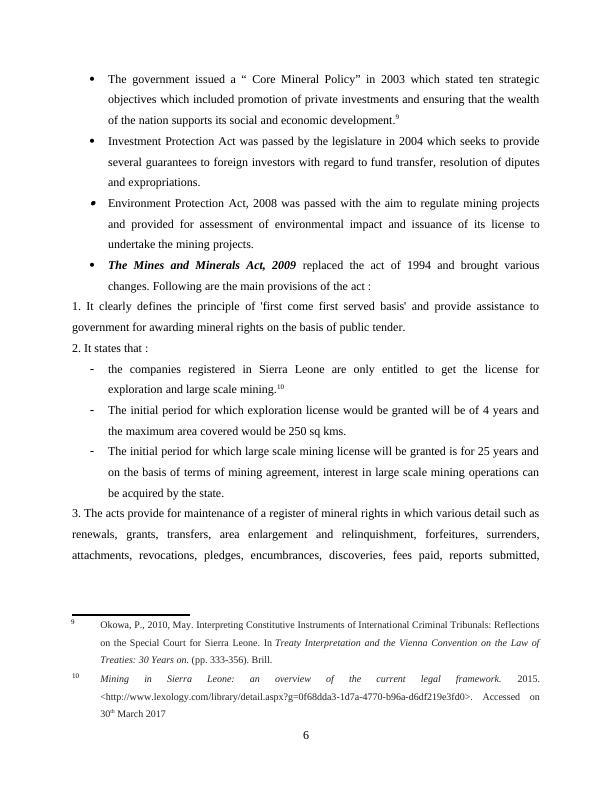
End of preview
Want to access all the pages? Upload your documents or become a member.
Related Documents
Environmental Legislation and Policylg...
|19
|4088
|99
Assignment On Environmental Lawlg...
|15
|5999
|1436
Implications of Precautionary Principle for Sustainable Development in Australialg...
|8
|2698
|272
Functions of State in Industrial Relations and Objectives of Legislationslg...
|6
|1454
|438
Laws Relating to Noise Nuisance and Environmental Management Systemlg...
|10
|2618
|27
Sustainability Management: A Comparison of Environmental Management and Planning in Australia and Canadalg...
|6
|1326
|487
